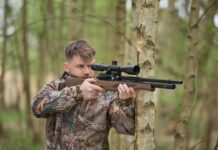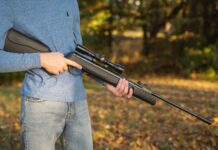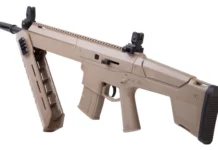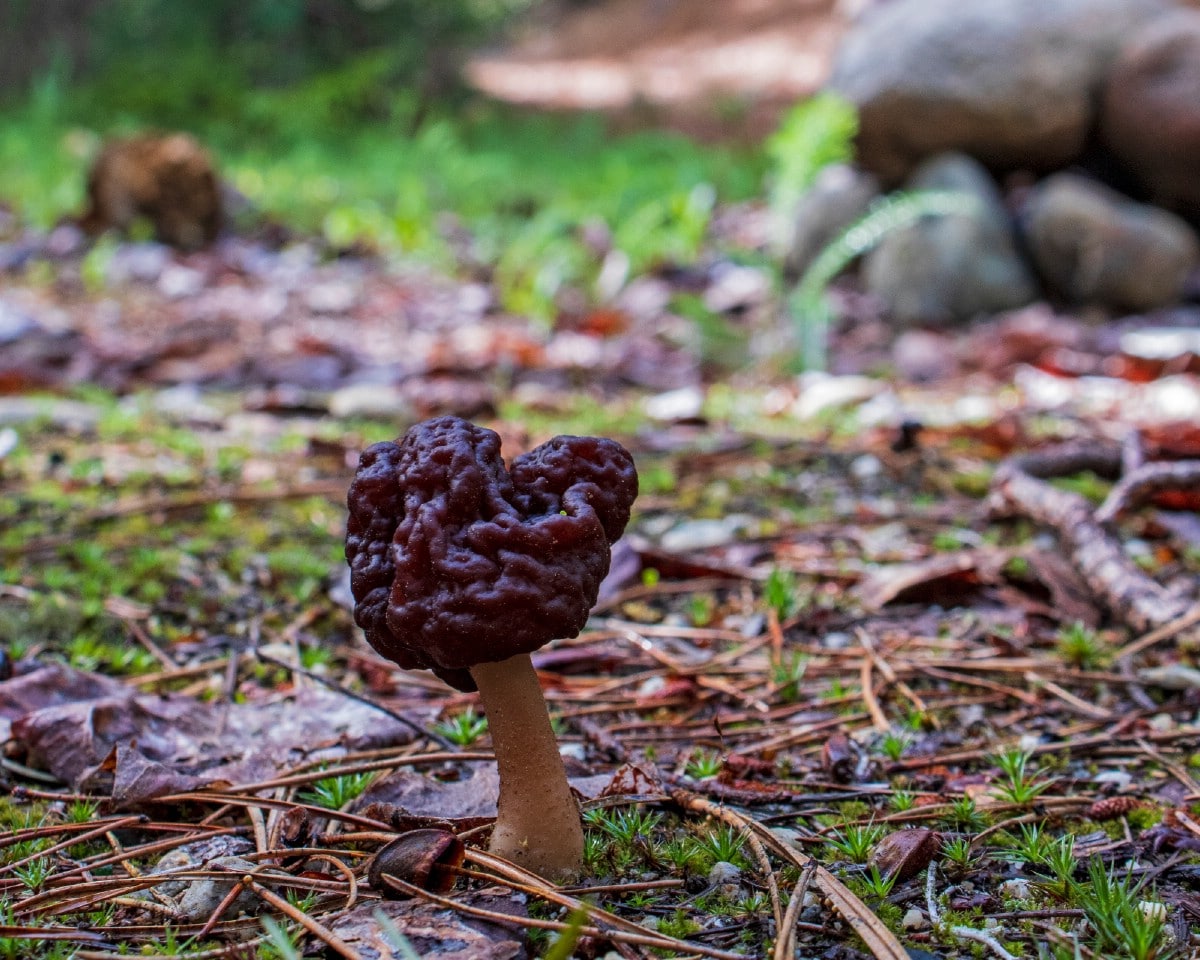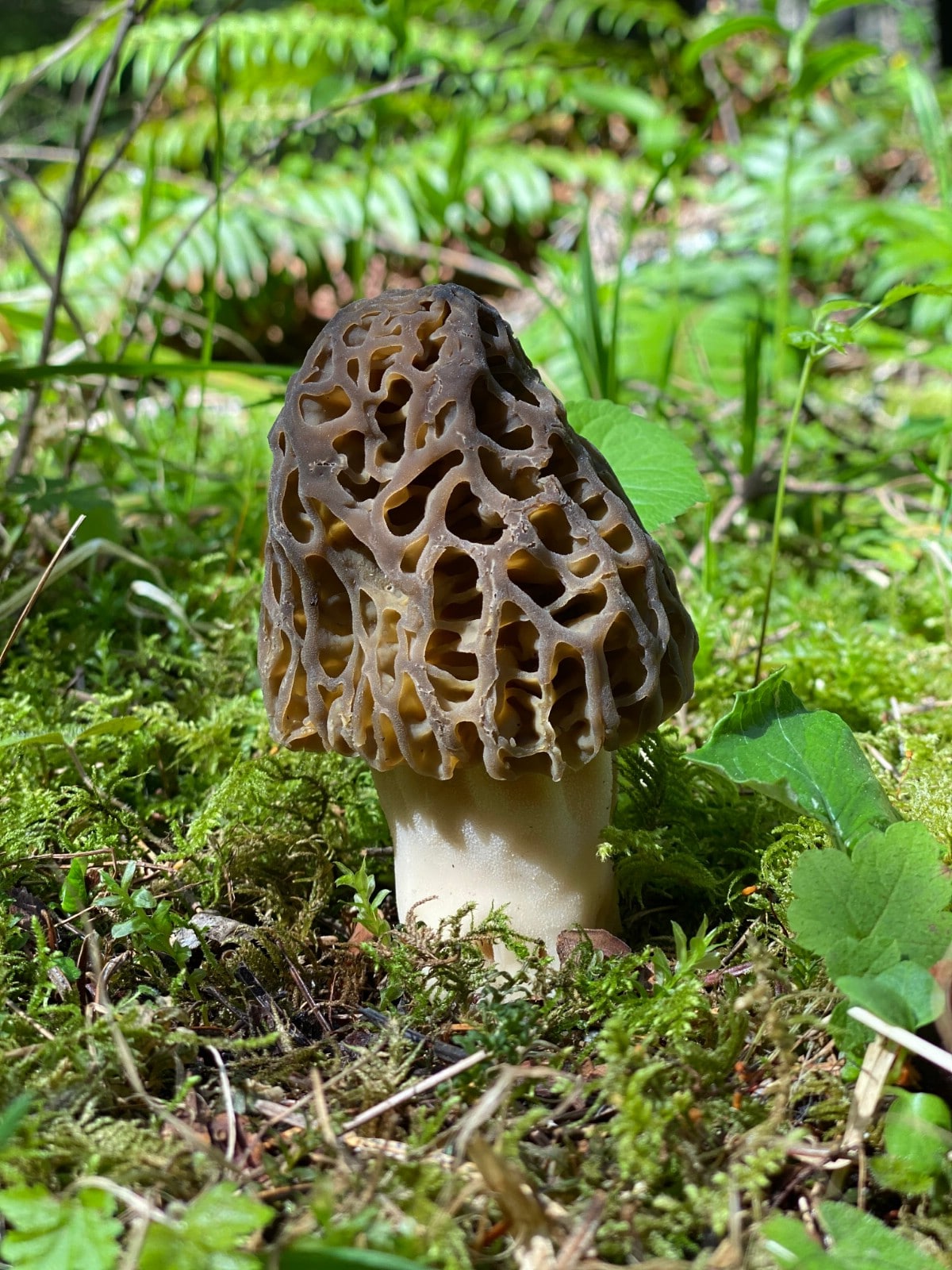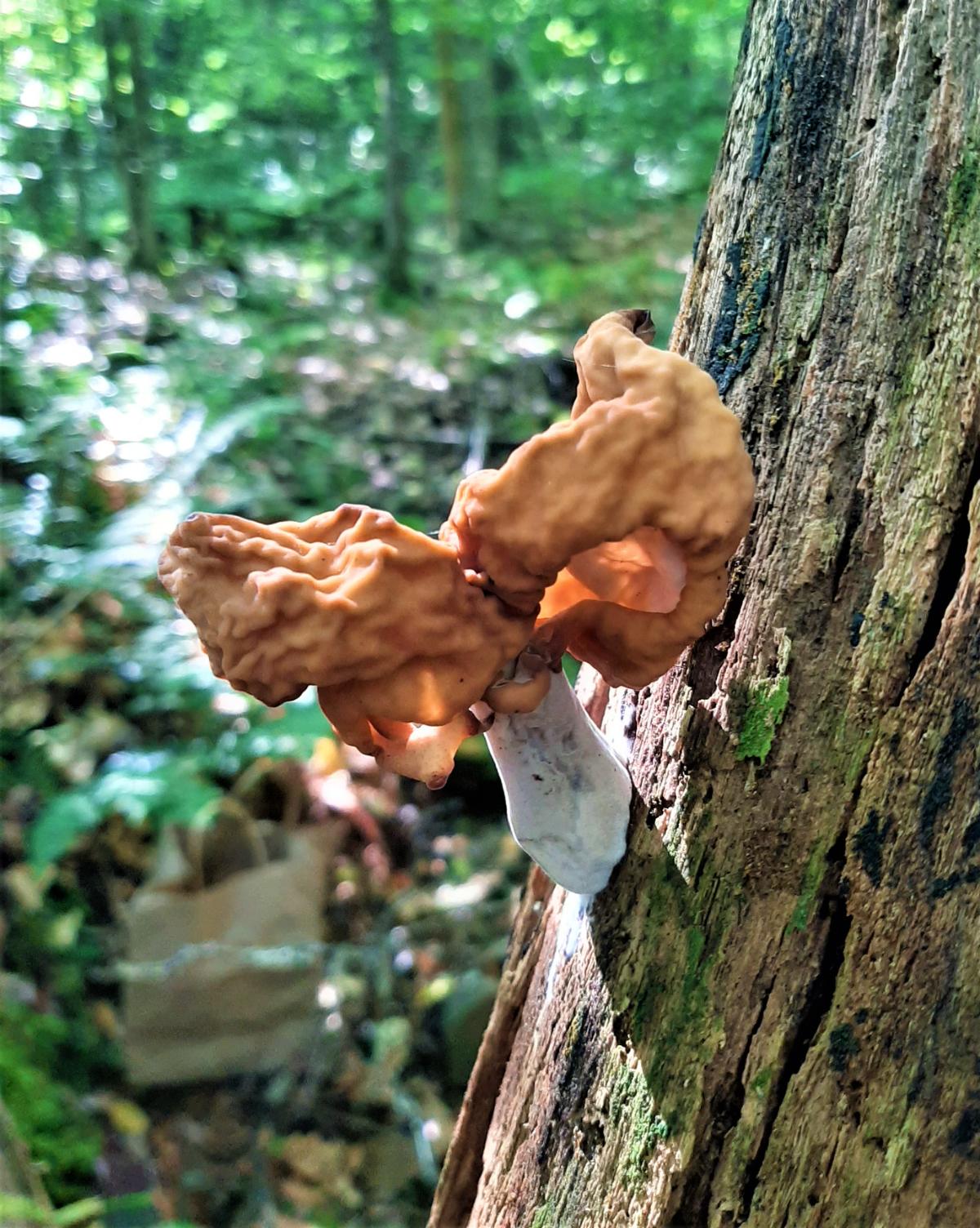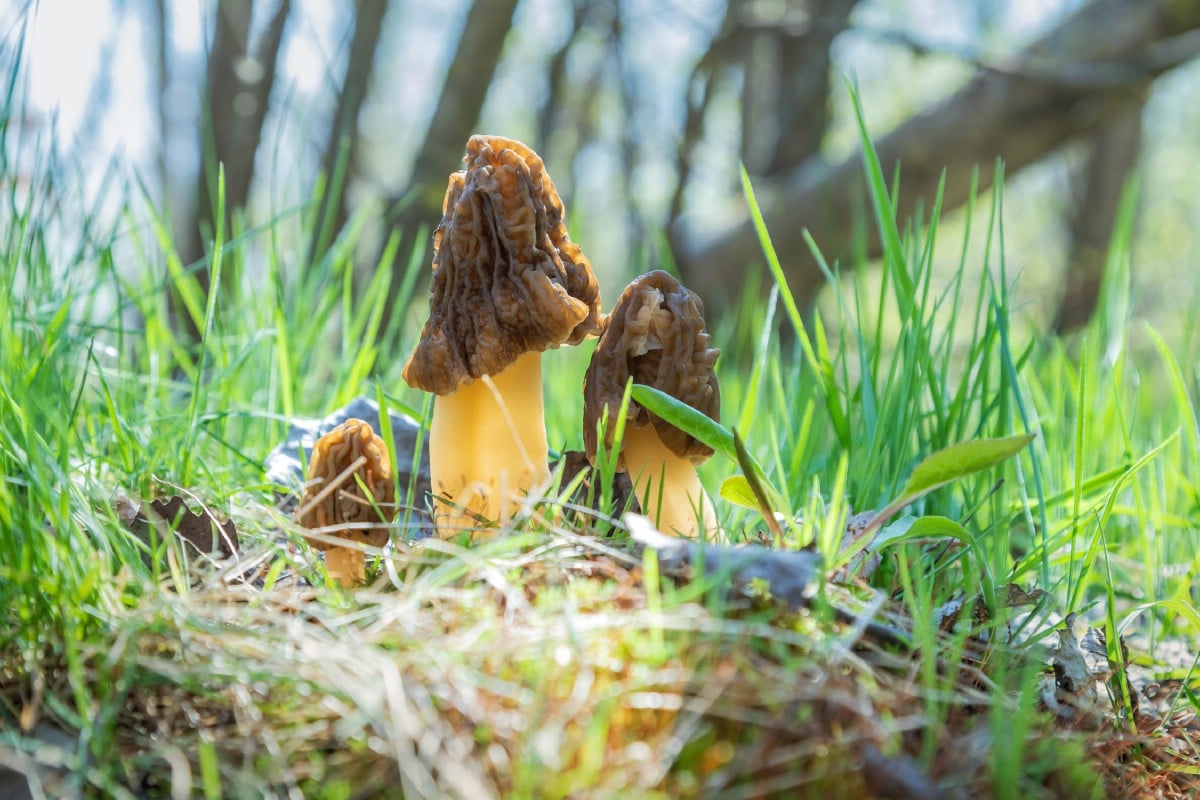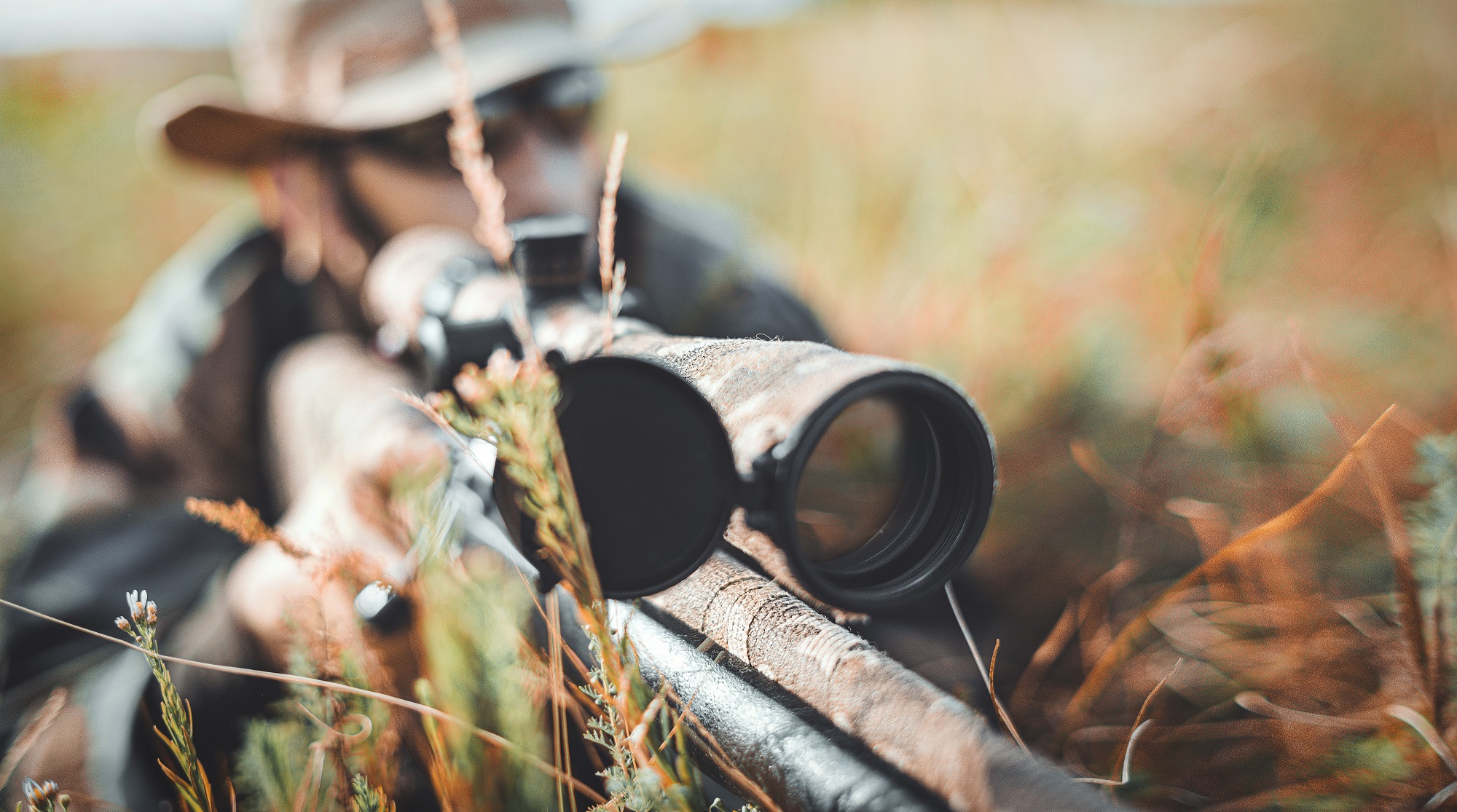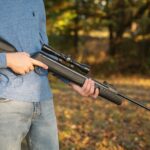Not sure what scope to get for your 1-8x?
Look no further.
I’ve tested ALL the best 1-8x scope (plus 1-8xscope mounts and accessories.)
By the end of this guide, you’ll find the perfect optic for your 1-8x.
Let’s get started!
1-6x vs. 1-8x Scope
If you’re looking for a versatile short to mid-range scope, 1-6x or 1-8x is your best bet.
But, what’s the difference between these two choices and which is better?
Keep reading to find out…
1-6x Scope
A 1-6x scope has a variable magnification from 1x to 6x and can be set anywhere in between.
This scope can pretty much do everything you could need. At a close range of about 25 yards, you’ll be able to target and shoot almost as quickly as you could with a red dot. Which makes these scopes a great choice for an SKS rifle or any home defense rifle.
At 6x magnification, you should be able to shoot out to 1000 yards, although not extremely accurately. The sweet spot is closer to 400 yards for optimum clarity and accuracy. This is great for 3 gun competitions and most hunting situations.
1-8x Scope
With the 1-8x scope, you’ll get an extra 2x of magnification range.
While you still get 1x magnification, this scope isn’t as great at the super short ranges. It’s most effective range is around 300-500 yards, with a little give or take above and below that.
It’s great for hunting, since that’s right around the normal distances that most people prefer to hunt. However, it does have some disadvantages to the 1-6x.
Which is better?
Both the 1-6x and 1-8x variable magnification scopes are great, depending on what your main function for them will be.
There’s only a few differences between the two scopes. The main difference is the eyebox. On a 1-8x, the eyebox noticeably shrinks. With a pickier eyebox, it can be a little more difficult to use.
But, if you’re bench shooting, it may not make a huge difference for you.
Another issue is the weight and the cost. Most of the time, a 1-8x scope will both be heavier and more expensive than the 1-6x. For something like a muzzleloader, the 1-8x is likely going to weigh you down. And if you’re looking for a scope under $100, 1-8x is likely out of the question.
The benefit to the 1-8x is, of course, that you get an extra 2x of magnification, which allows you to target and shoot further. It also usually will have better glass quality than the 1-6x. Although that will really depend on the scope brand.
But, the 1-8x has to be at full magnification for the reticle to give you the best results. And that extra 2x of magnification almost always coincides with a loss of clarity, as well as a tighter eyebox.
In most cases, the 1-6x is the better choice. It does almost everything and has the best overall value. The benefits of the 1-8x don’t really outweigh the downsides, unless you really need the extra magnification. So, if you do a fair amount of long range shooting, the 1-8x might be worth it.
Another thing you’ll want to consider when choosing the right scope is whether the reticle is first focal plane or second focal plane…
What is the Difference Between First Focal Plane and Second Focal Plane?
There are a few key differences between these two types of scopes, which should help you to decide which is better for your setup.
First Focal Plane
First Focal Plane, or FFP, scopes have the reticle right in front of the magnification lens. What this means is that when the magnification changes, so does the reticle.
The reticle will increase or decrease in size as the magnification gets higher or lower.
The benefit to this type of scope is that the holdover or subtension values stay consistent and accurate, no matter the magnification. This makes it the best suited for long range shooting.
The downside to this is that the reticle can get pretty small at lower magnifications, making it difficult to see. Also, the reticle gets bigger and thicker at high magnifications, and the lines could block part of your view.
On top of that, FFP scopes are quite a bit more expensive than the SFP.
Second Focal Plane
Second Focal Plane, or SFP, scopes have the reticle behind the magnification lens. So, with these, the reticle doesn’t change its size at all.
The great thing about this is that the reticle is strong and easy to see, no matter the magnification. And it doesn’t get in your way at all.
Unlike the FFP, short range shots are quick and easy to see, which makes SFP perfect for home defense and close range hunting like you’d do with a 45-70 or any other hunting rifle.
Another bonus is that SFP scopes are a lot more affordable than the FFP scopes.
The downside is that the spacing for holdover is only correct at the highest magnification. Which means that you’ll have to calculate it when you’re using it at the lower magnification settings.
When you’re trying to choose between the two, the SFP is most common and the popular choice. Unless you do a lot of really long range shooting or long range competitions, which is where the FFP scopes excel, the SFP is a better overall value.
The 5 Best 1-8x Scope
If you’re pressed on time, here’s a quick list of the best 1-8x scope:
- Swarovski Optiks L Z8i 1-8×24: Best 1-8 Scope
- Athlon Argos BTR GEN2 1-8×24: Best for AR-15
- UTG 1-8×28: Best for the Budget
- Primary Arms SLx8 1-8×24 FFP: Best 1-8x FFP Scope
- Vortex Razor HD 1.5-8×32: Best for Hunting
1. Swarovski Optiks L Z8i 1-8×24: Best 1-8 Scope
If you are in the market for a scope to use with your 45-70 and want the best in the industry, look no further than Swarovski Optiks.
The Swarovski Optics L Z8i 1-8×24 is the clearest scope on the market.
Let me tell you why….
Glass Clarity & Reticle
Swavorski sets the standard for best optics glass in the industry-hands down. No one does it better than this Austrian company. A few may come close-but they can’t quite cut it.
Between near perfect glass clarity and the fully-multi coated lenses, the L Z8i line transmits 93% of visible light.
Meaning this is the clearest and brightest view through an optic that you’ll ever see. After using this scope, even my “best” scopes seem hazy.
The view on this scope is truly clear and precise from edge-to-edge. Other scopes may claim they have edge-to-edge clarity, but really, they only have 70% of the range this scope has.
There’s no fuzzing at the edge of objects. I couldn’t get a sharper sight picture if I had cut it with an exact-o knife.
When I took this optic out to the range, I didn’t need a spotter. I could clearly see all the hits on my paper-even pushing passed 500 yards. There’s no questioning where my shots landed.
This scope is outstanding and as Swarovski’s flagship line, the Z8i 1-8×24 outperforms all other scopes you’ll ever use in low-light situations.
The illuminated Flex-change 4A-IF reticle gives me a fully adjustable red dot. Or if I’d prefer, I can toggle to a red dot centered in an illuminated red circle.
The red dot illumination levels are the most adjustable I’ve ever seen: there are 64 different intensity levels.
The scope also features an ingenuitive battery saving feature-if the scope senses that the rifle isn’t being held at a shooting angle, it turns the red dot off.
The reticle cross hairs are thin and unobstructive. I can clearly see my target. The Z8i 1-8×24 comes with either a BDC reticle or a simple duplex.
If you have an eye condition that makes red dots hard to see, you might be interested in holographic sights.
Eye Relief & Eye Box
The eye relief on this particular Swarovski is pretty standard: 3.74 inches (95mm).
I found the eyebox forgiving. I use this scope in 3-gun competitions and I can easily see my shots from cover or around odd angles.
Durability
The Swarovski L Z8i 1-8×24 is nitrogen purged to prevent fogging.
The aluminum housing is sturdy and strong. It holds up to heavy recoil and can take a beating. As I said, I use this for 3-gun competitions so it gets thrown around and beat up.
This scope isn’t a “gun-safe queen” that I only bring out to the range on sunny days. I don’t treat it softly. It’s a tool and I work it hard.
Elevation & Windage Knobs
The Swarovski L Z8i’s turrets turn with 0.1 MRAD clicks. The turrets turn with a tactile click that I can hear and feel.
The turrets are compact and unobtrusive. They are easy to turn.
Swarovski offers turret upgrades called Ballistic Turret Flex or BTF. These are aftermarket turrets you can swap out for both the elevation and windage ones that come standard from the factory.
They cost about $300 each and you don’t need extra tools to install them.
What’s the benefit of the BTF turrets?
Well, they allow me to set zeros for 3 different distances to better fine-tune your shots.
For example I can set and save zero for 100 yards, 250 yards and 500 yards to improve accuracy and take the guesswork out of hold overs or hold unders.
Personally, I think they are a worthwhile upgrade. If you’re going to spend almost $3000 on the scope, spending an extra $600 for pin-point customized accuracy is a no-brainer.
Parallax & Magnification
The magnification range on this Z8i is 1-8x. The single power is a near perfect 1x. The true 1x paired with an illuminated reticle makes it easy to engage close range targets with both eyes open.
The 8x is impressively clear. I could easily pop 6 inch steel targets from 800 yards.
With the aid of a throw lever, I can slam through the magnification range on the Z8i for quick target acquisition or identification-making this a perfect optic for defensive or battle use.
There’s no questioning my target in low light situations because I can clearly see it.
Check out my list of the other top 1-6x scopes on the market for a comparison.
Mounting & Rings
This optic has a 30mm tube. Any 30mm ring set will work quite well. I prefer to use these mounts from Vortex. They are only compatible with a picatinny rail. They won’t mount to a weaver.
Is the Swarovski L Z8i 1-8×24 worth it?
Swarovski set a high bar for optic clarity that all optics companies are trying to reach. As Swarovski’s flagship scope line, the Z8i is the best scope you can buy.
They don’t need any extra bells and whistles that other companies add to their optics to distract you from their inferior glass and coatings.
As such the Swarovski L Z8i 1-8×24 is the worth it because it has:
- Durable design
- Flex-Change reticle
- Unbelievable clarity
- 93% Light transmission
Why settle for any old optic, when you can get the best?
2. Athlon Argos BTR GEN2 1-8×24: Best for AR-15
The Athlon Argos BTR Gen2 has a set of features that make it perfect for the AR-15.
In fact:
I’ve personally bought and hand-tested this scope to see if these claims were true, and they most certainly were.
Need proof? I’ve got it all laid out down below.
Glass Clarity and Reticle
The excellent glass quality gave me a picture with no distortion or blurring to be seen. Nothing but a crisp, crystal clear image of the target.
The glass is fully multi coated and excels at drawing in ambient light for a much brighter picture. Its anti-reflective glass reduces light reflections, making it perfect at drawing less attention to your position.
The reticle is horseshoe shaped and works perfectly for aiming at silhouettes. It draws my eye to the target quickly and is useful even at maximum range. I was especially impressed with how simplistic it was so that I could focus on what I was aiming at.
I was impressed by the illuminated reticle. Targeting was a breeze even around dawn and dusk, especially when combined with the multi coatings ability to draw in ambient light.
Eye Relief and Eye Box
The eye relief is a generous 3.4” and led to no issues even at max range.
As I expected once I saw how great the glass quality was, I didn’t suffer from eye fatigue even after several hours of use. The glass is clear all the way through and even around the edges there was no sign of blurring or distortion.
Eye box was also a non-issue. I was able to easily center my picture and didn’t have to get into an uncomfortable position to do it.
Durability
The Athlon Argos BTR Gen2 was designed to be as durable as possible.
During testing I dropped it, banged it around, and fully submerged it in water. The high levels of abuse didn’t even scuff the exterior of the scope, much less damage the interior. It also held my zero with no issues throughout the testing.
How was it able to do all of this?
The aircraft grade aluminum this scope is made of can already handle just about anything you can throw at it, but it also has an XPL coating on the lenses.
This prevents any dirt or oil from affecting the glass and helps prevent any scratches.
It’s also argon purged and completely waterproof.
You won’t have to worry about any fogging or moisture damage even in the roughest of terrains. The one tube construction gives it an extra layer of durability as well.
Elevation and Windage Turrets
The turrets on the Athlon Argos BTR Gen2 are top of the line.
Each adjustment gave crisp audible clicks just as good turrets should. Even with heavy recoil they never adjusted without me wanting them to, which is one of the top criteria I expect from them.
The best part?
It only took me 20 rounds to find my zero, and it solidly held it for the next 300 after that.
Parallax and Magnification
The parallax is fixed at 100 yards, and even bouncing between magnifications this proved to work just fine.
The magnification is 1-8x. The Athlon Argos BTR Gen2 is capable of landing some pretty distant shots, but its real strength is in the close to mid range. It is best used for close quarters combat, target shooting, or hunting.
While this scope would go best with an AR, even higher power rifles work well with it. I also slapped this scope on one of my lever actions, and it’s without a doubt the best scope for Marlin .45-70.
Mounting and Rings
The Athlon Argos BTR Gen2 does not come with any mounting or rings.
I highly recommend getting the Vortex Optics Pro Series rings, as they mesh very well with this particular scope. $60 for the 30mm is a small price to pay for keeping your scope secure.
Is the Athlon Argos BTR GEN2 worth it?
If you’re looking for a scope for your AR-15 that can deliver amazing glass quality, incredible durability, and unmatched versatility, then look no further than the Athlon Argos BTR Gen2.
Here’s why:
- Audible turrets
- Extreme durability
- Crystal clear multi-coated glass
- Horseshoe reticle for easy silhouette targeting
To sum it up: this scope has an amazing set of features that would be at home on any sort of semi-automatic rifle.
It’s a very reasonable price for the product’s quality, and I’m honestly surprised it wasn’t higher. The level of effort that was put in to make this scope incredibly durable with the high quality glass is clearly well above the norm.
So if you need an AR-15 scope that can handle any situation you get into, then look no further than the Athlon Argos BTR Gen2 1-8×24.
3. UTG 1-8×28: Best for the Budget
Searching for an all-around budget scope is tiring.
I’ve found one for you.
And it’s the best scope deal anywhere. Here’s why.
Glass Clarity & Reticle
Clear glass. Super clear.
The fully-multicoated emerald coatings on this scope allow maximum light transmission. With the 28mm objective lens, lighting just before dawn or after dusk can be tricky at high magnification, but it works well through most of the range.
In low light conditions, it will provide plenty of brightness at 5x or less to pop those pesky critters that keep attacking the chicken coop.
There are several reticle options available, so get the one you prefer. A BDC is available that is pre-set for .223 or 5.56 rounds, making this the perfect budget scope for an AR-15. It also comes in mil-dot and dot-circle variants.
In all cases, the reticle is etched, so if the battery dies you will still have a point of aim.
All of the extra colors seem a bit excessive to me personally, but I have mine set on the brightest red I could find and I just leave it there. If you want more color options, there are 36 in total, so you can go red, green, blue, yellow, teal, or whatever you want.
Eye Relief & Eye Box
Some say that a “true” 1x scope should have infinite eye relief, but the reality is that complex lens arrangements make this impossible.
Still, I tested the eye relief as soon as I picked up the scope, and at 1x I could fit my whole hand between my eye and the scope and see just fine. Then I read the specs.
A whopping five inches of relief at 1x, and it only drops to 3.4 inches at 8x. In short, the eye relief is plenty for any application, especially high kick rifles. It’s probably the best scope for lever action 45-70.
The eye box is roomy, bigger than the front objective, making the whole setup very pleasant in both hunting and battle situations.
Durability
UTG continues to innovate, trying to keep up with the likes of Leupold and other top manufacturers, while keeping their price point down.
The tube is nitrogen purged and sealed with o-rings to ensure that it is water tight and will never fog up.
They’ve also started using this coil erector return spring on some of their scopes. Think of this like the shocks on your car. Even under heavy recoil or an occasional bump, the inner guts are protected from damage and remain solid, holding your zero under adverse conditions.
It also uses a smart spherical structure to maintain integrity of the outer skin to inner components. Every piece of this scope was designed around being tough, and it lives up to that reputation on top of my .308.
With the included heavy-duty mount, all of this strength does come at a cost. The scope itself is 18oz and mounted can be over a pound and a half. More on the mount later.
Elevation & Windage Knobs
The turrets have a solid click, a feature that I like.
There’s nothing worse than mushy turrets that make you take your eye off the target just to ensure that you have the right elevation dialed in for the range.
The ½MOA clicks are fast to dial in, and there are no caps in the way, so you can click over to the proper elevation and windage easily.
Parallax & Magnification
Parallax is fixed at 100 yards. This may bother some people, but if you have a solid cheek weld, you really can’t ask for more from a budget scope.
For the price of an air rifle scope, the important thing is how well the secondary focal plane and optical path are aligned. Even without adjustment, the maximum deviation due to parallax isn’t going to be enough to affect the shot too much, unless you are looking for a competition scope.
Mounting & Rings
The UTG 1-8X28 comes with its own mounting system. Depending on which variant you purchase, it will come with a single clamp mount for a Picatinny rail or two rings that will work with Picatinny or Weaver rails.
As I mentioned earlier, the scope rings are a little heavy, but they are also built ultra-rugged. This review on youtube suggested that you could smack the mount with a hammer and not budget:
I wouldn’t recommend that, but it is a super solid mounting system.
Is the UTG 1-8×28 worth it?
The UTG 1-8x28mm scope is the best all-around scope for the price, period.
For hunting, target shooting, combat, you name it, you won’t find a better optic for even twice the price. The only applications where you might want something else if if you needed a red-dot scope or a true long-range target scope.
- Fully-coated optics
- Responsive tactile clicks
- Wide magnification range
- Layers of durability through design
- Includes mounting rings, battery, and more
By the way, it also comes with a lifetime warranty from UTG!
If you want the best all-around scope for the money, the UTG 1-8×28 is it, hands down.
4. Primary Arms SLx8 1-8×24 FFP: Best 1-8x FFP Scope
If you’re looking for the best 1-8x FFP scope, the Primary Arms SLx8 is the answer.
Not only does it have all the features you’d need in this type of scope, it’s also pretty lightweight and compact.
Once I tried it, I was hooked.
Want to know why? Keep reading…
Glass Clarity & Reticle
The Primary Arms SLx8 has amazing glass quality for the price.
In fact, I was surprised that the glass was just as crystal clear as scopes twice the price.
The lenses are fully multi-coated, which draws in more light and decreases glare for the brightest, clearest sight picture.
Plus, it has a ACSS® Raptor reticle, which is a first focal plane and extremely accurate at all available magnifications. It’s also designed specifically for AR-15, AK-47, and M4 rifles.
What’s great about this reticle is that at 1x it’s basically like a small red dot, which makes for super fast target acquisition like you’d need at close quarters.
Then, at the higher magnifications, you get the full Advanced Combat Sighting System, which allows you to make precision shots out to 600 yards.
On top of that, it has 11 illumination settings and even has one that works perfectly in the brightest part of the day. All powered by one CR2032 battery that comes with the scope. And it comes with a spare!
Eye Relief & Eye Box
The eye relief on the Primary Arms SLx8 1-8×24 FFP is very forgiving.
It’s 3.2 inches – 3.3 inches, which means you really shouldn’t need to worry about the eye relief on this scope, especially if you’ve got a good cheek weld.
Also, this scope has a quick focus eyepiece, which helps you to get on target faster than ever.
Durability
Primary Arms is well known for its high quality products and the SLx8 1-8×24 FFP scope is no different.
It’s lightweight and compact, which makes it perfect for any setup.
Plus, it’s waterproof and fogproof, so it’ll function in any type of weather. And I can attest to this, as I’ve dropped mine in a puddle while out hunting. It came out working just the same as before.
It also comes backed with a lifetime warranty, so even if you had a problem, Primary Arms will help you get it sorted out.
Elevation & Windage Knobs
The elevation and windage knobs are ¼ MOA click adjustments.
The turrets adjust easily with just a finger click and there’s both a tactile and audible, solid click for each adjustment.
They are also low profile, which is really nice. Plus, they come with turret caps.
What about zeroing?
It’s quick and easy. I had mine zeroed in 6-7 shots at 100 yards. So far, it’s been dead on accurate and after 500 rounds, it’s still held zero.
Parallax & Magnification
The Primary Arms SLx8 has a variable magnification of 1-8x.
This is the perfect range for close to mid-range distances. Basically, it works perfectly for close quarters combat, out to varmint hunting and big game hunting ranges.
1-8x is probably one of the most popular rifle scope magnification ranges because it pretty much gets you everything you could need. Unless you’re doing long range competitions or need to shoot past 600 yards, which is not as common.
As far as parallax, it’s fixed at 100 yards and I haven’t noticed any distortion.
Mounting & Rings
This scope doesn’t come with a mount, so you’ll need to purchase one separately, but considering the quality of this scope and the affordable price point, that’s to be expected.
I recommend the Primary Arms Basic AR-15 scope mount.
It works great and that’s what I use for my AR-15 mount.
Is the Primary Arms SLx8 1-8×24 FFP worth it?
This scope is a great quality 1-8x scope at an affordable price compared to the competition.
You’ll get:
- Crystal clear glass
- Lightweight, compact
- Fully multi-coated lenses
- FFP ACSS® Raptor reticle
- Low profile, precise, capped turrets
- Short to mid-range precision accuracy
In short, you’ll get everything you could ask for out of a 1-8x rifle scope. Try the Primary Arms SLx8 1-8×24 FFP scope. You’ll be happy you did.
5. Vortex Razor HD 1.5-8×32: Best for Hunting
The Vortex Razor HD 1.5-8×32 is the best scope for hunting, hands down.
In fact,
This is the best Vortex glass I’ve owned yet, and its clarity alone has given me the opportunity for crazy shots while hunting.
Want to know more? Here’s how…
Glass Clarity & Reticle
The Vortex Razor HD has crystal clear glass.
It’s sharp and bright with edge to edge clarity with optically indexed lenses.
The lenses are fully multi-coated and the proprietary XR Plus Fully Multi-Coated anti-reflective coating makes sure that the scope doesn’t compromise your position.
The lenses have HD Elements like premium extra-low dispersion glass. This delivers the ultimate color and clarity for high-definition imaging in the field.
The glass actually comes from the same factory as Trijicon and the higher end Leupold scopes- same quality, with half the price tag.
It comes with a G4 BDC reticle which is super clean, highly versatile, and crisp. Your eye is drawn to the fine dot in the center, even in low light.
The G4 features five hash marks and a simple sight picture. It’s a viable option for all classes of rifles- muzzleloaders, varmint, standard, and even magnum calibers.
This reticle works well for me and I’ve come to prefer the clean field of view on the top half of the glass. It’s saved me critical seconds in the field.
The locking ocular focus ensures your reticle always stays sharp and crisp after you’ve adjusted it.
Eye Relief & Eye Box
The Vortex Razor HD has 3.8 inches of eye relief and a very forgiving eye box.
It’s a comfortable distance for nearly any application. But practicing good cheek weld is always a good idea.
Durability
I’ve yet to be disappointed with Vortex’s quality and this scope once again checks all of the durability boxes.
Overall, the Vortex Razor HD has a rugged construction that’s waterproof, shockproof, fogproof, and ready for whatever you throw at it.
Plus, the lifetime warranty is great for my peace of mind.
First, it’s fully waterproof. The O-ring seals make sure it stays that way by preventing moisture, dust, and debris from penetrating the optic.
The single-piece tube ensures its waterproofness while also enhancing your base optics.
The scope’s Argon gas purged body means that the scope is fog-free over a wide range of temperatures or fluctuations. You’ll have a clear shot whether that’s in the snow, sun, or rain.
The one-piece tube construction is also better at keeping out moisture, keeping your scope fog proof for the rest of its life. Plus, with less moving parts, it’s more durable for heavy recoils.
Scopes have to endure a lot in the field. The Vortex Razor HD is prepared to take a beating thanks to the ArmorTek coating, hard anodized finish, and aircraft-grade aluminum construction.
At only 13.4 oz, this optic is incredibly light and built for speed. I hate lugging around heavy optics every day during a hunting trip.
The smaller scope size (only 11 inches long) also means you can run a lighter rifle with a lower profile- music to the backcountry hunter’s ears.
Elevation & Windage Knobs
The elevation and windage turrets are almost perfect.
Their large diameter makes the adjustments easy to read, accurate, and faster.
Plus they’re capped turrets which is a must for me. This gives them external protection that’s especially helpful when making long stalks in open country.
But they’re mushy.
The adjustments knobs feel soft and don’t have a strong click to them.
Despite the mushy feeling, they do track properly. This is the only con I’ve found with the scope so far.
Parallax & Magnification
The magnification ranges from 1.5x to 8x.
This is a broad and versatile range that’s ideal for hunting.
It might not deliver extreme long distances, but it’s optimized for close- and mid-range shooting with the capacity to 600 yards on a centerfire.
Plus, on a technical note, the zoom lens mechanism glides smoothly and cleanly through all magnification ranges due to the internal precision-glide erector system.
The parallax setting is fixed to 100 yards and has worked well for me so far.
Mounting & Rings
With the compact size, this optic fits best on a short action rifle. I recommend the Vortex Optics Pro Series Riflescope Rings in the 1-inch size.
Plus, those specific rings will work with a Ruger Scout as the ocular bell clears the scout Picatinny mount by a few thousandths of an inch without removing the scout mount.
The tube is too short to mount on a long action rifle using a standard mount, but it could work if you were to install a rail or cantilever mounts.
In the box, you get a 3-inch sunshade as well which has come in handy out in the field.
Is the Vortex Razor HD 1.5-8×32 worth it?
The Vortex Razor HD 1.5-8×32 is an incredible optic that packs premium durability and crystal clear glass into a lightweight, compact package.
It’s a great addition for sub-600 yard rifle hunters and shooters looking for a lightweight, optically superior, riflescope.
Here’s why it works:
- G4 BDC (MOA) reticle
- Large Diameter Turrets
- Vortex lifetime warranty
- XR™ Plus Fully Multi-Coated
- HD (High Density) extra-low dispersion glass
In short, this scope will give you the added accuracy you need at a reasonable price for your next hunting trip.
If you’re looking to dramatically improve your shooting accuracy, the Vortex Razor HD 1.5-8×32 will get you the results.
Now It’s Your Turn
I hope you enjoyed my best 1-8x scopeguide.
Now I want to turn it over to you:
Which rifle scope will you pick for your 1-8x?
Let me know by leaving a quick comment down below.

